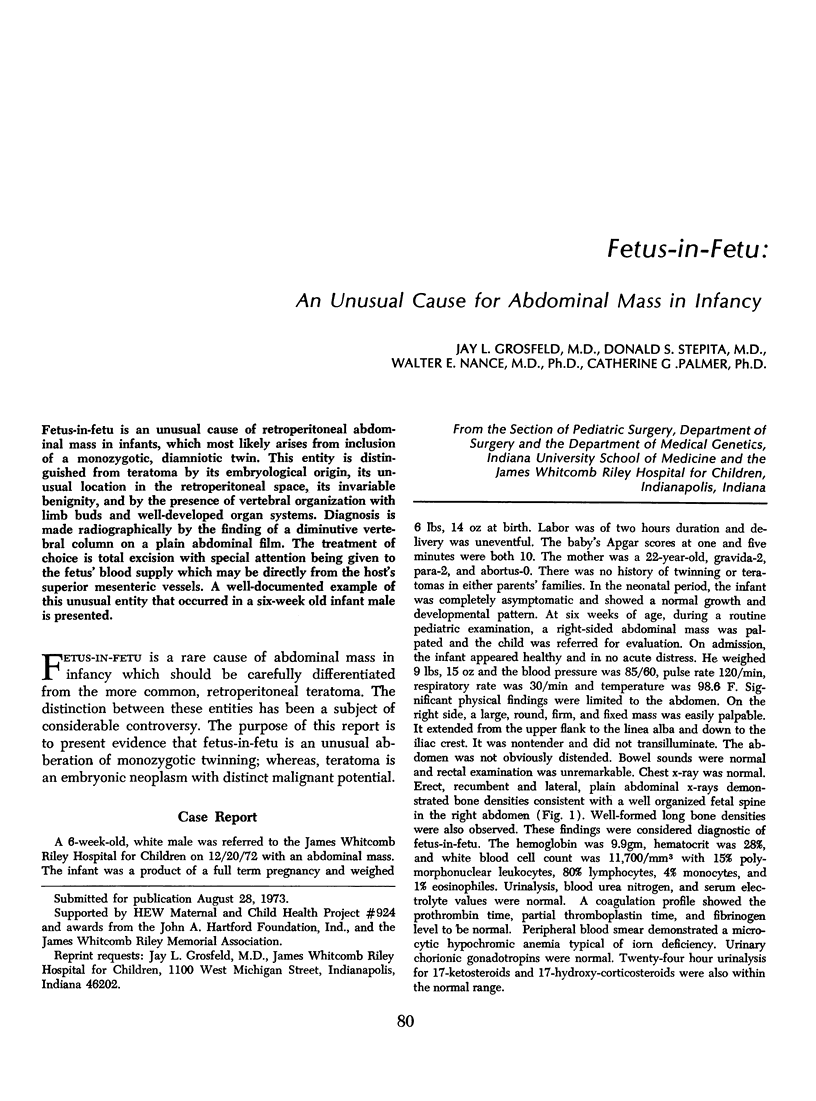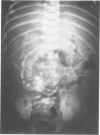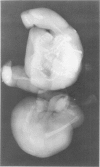Abstract
Fetus-in-fetu is an unusual cause of retroperitoneal abdominal mass in infants, which most likely arises from inclusion of a monozygotic, diamniotic twin. This entity is distinguished from teratoma by its embryological origin, its unusual location in the retroperitoneal space, its invariable benignity, and by the presence of vertebral organization with limb buds and well-developed organ systems. Diagnosis is made radiographically by the finding of a diminutive vertebral column on a plain abdominal film. The treatment of choice is total excision with special attention being given to the fetus' blood supply which may be directly from the host's superior mesenteric vessels. A well-documented example of this unusual entity that occurred in a six-week old infant male is presented.
Full text
PDF




Images in this article
Selected References
These references are in PubMed. This may not be the complete list of references from this article.
- FARRIS J. M., BISHOP R. C. Surgical aspects of abnormal twinning. Surgery. 1950 Aug;28(2):443–453. [PubMed] [Google Scholar]
- GALATIUS-JENSEN F., RAH D. H., UHM I. K., THORBORG J. "FOETUS IN FOETU". Br J Radiol. 1965 Apr;38:305–308. doi: 10.1259/0007-1285-38-448-305. [DOI] [PubMed] [Google Scholar]
- GROSS R. E., CLATWORTHY H. W., Jr Twin fetuses in fetu. J Pediatr. 1951 Apr;38(4):502–508. doi: 10.1016/s0022-3476(51)80037-4. [DOI] [PubMed] [Google Scholar]
- Galton M., Benirschke K., Baker M. C., Atkin N. B. Chromosomes of testicular teratomas. Cytogenetics. 1966;5(3):261–275. doi: 10.1159/000129902. [DOI] [PubMed] [Google Scholar]
- Grant P., Pearn J. H. Foetus-in-foetu. Med J Aust. 1969 May 17;1(20):1016–1019. doi: 10.5694/j.1326-5377.1969.tb49866.x. [DOI] [PubMed] [Google Scholar]
- HICKEY R. C., LAYTON J. M. Sacrococcygeal teratoma; emphasis on the biological history and early therapy. Cancer. 1954 Sep;7(5):1031–1043. doi: 10.1002/1097-0142(195409)7:5<1031::aid-cncr2820070531>3.0.co;2-9. [DOI] [PubMed] [Google Scholar]
- HUNTER W. F., LENNOX B. The sex of teratomata. Lancet. 1954 Sep 25;267(6839):633–634. doi: 10.1016/s0140-6736(54)90406-7. [DOI] [PubMed] [Google Scholar]
- JANOVSKI N. A. Fetus in fetu. J Pediatr. 1962 Jul;61:100–104. doi: 10.1016/s0022-3476(62)80236-4. [DOI] [PubMed] [Google Scholar]
- Kakizoe T., Tahara M. Fetus in fetu located in the scrotal sac of a newborn infant: a case report. J Urol. 1972 Mar;107(3):506–508. doi: 10.1016/s0022-5347(17)61064-4. [DOI] [PubMed] [Google Scholar]
- LEWIS R. H. Foetus in foetu and the retroperitoneal teratoma. Arch Dis Child. 1961 Apr;36:220–226. doi: 10.1136/adc.36.186.220. [DOI] [PMC free article] [PubMed] [Google Scholar]
- Linder D., Power J. Further evidence for post-meiotic origin of teratomas in the human female. Ann Hum Genet. 1970 Jul;34(1):21–30. doi: 10.1111/j.1469-1809.1970.tb00216.x. [DOI] [PubMed] [Google Scholar]
- Wedge J. J., Grosfeld J. L., Smith J. P. Abdominal masses in the newborn: 63 cases. J Urol. 1971 Nov;106(5):770–775. doi: 10.1016/s0022-5347(17)61394-6. [DOI] [PubMed] [Google Scholar]





